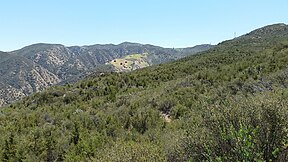Santa Ana Mountains
| Santa Ana Mountains | |
|---|---|
 | |
| Highest point | |
| Peak | Santiago Peak |
| Elevation | 5,689 ft (1,734 m) |
| Coordinates | 33°42′38″N 117°32′03″W / 33.71056°N 117.53417°W |
| Dimensions | |
| Length | 61 mi (98 km) |
| Area | 2,104 sq mi (5,450 km2) |
| Geography | |
| Country | United States |
| State | California |
| Counties | Metasedimentary[1] |
The Santa Ana Mountains are a short peninsular mountain range along the coast of Southern California in the United States. They extend for approximately 61 miles (98 km) southeast of the Los Angeles Basin largely along the border between Orange and Riverside counties.
Geography and climate
Peaks and boundaries
The range starts in the north at the Whittier Fault and Santa Ana Canyon, through which the Santa Ana River flows. To the north of the canyon are the smaller Chino Hills in Los Angeles and San Bernardino counties.[1] The northernmost summit of the Santa Anas, at 3,045 feet (928 m), is Sierra Peak. From there, the major summits are Pleasants Peak, 4,007 feet (1,221 m); Bedford Peak, 3,800 feet (1,200 m); and Bald Peak, 3,947 feet (1,203 m). The next two peaks — Modjeska, 5,496 feet (1,675 m); and Santiago, 5,689 feet (1,734 m),[3] the highest summit in the range — form Saddleback Ridge. Saddleback, located approximately 20 mi (32 km) east of Santa Ana, is visible from much of Southern California.

South of Saddleback are
Much of the range is within the Trabuco Ranger District of the
Waterways
The Santa Anas include a number of high-mountain streams that flow for all or most of the year, although once out of the foothills these waterways are
Water from the north-east side of the range empties into Temescal Creek which flows north to the Santa Ana River,[4] or Lake Elsinore which intermittently overflows to Temescal Creek. The southeast end of the range is marked by the Santa Margarita River, which also originates east of the Santa Anas and flows southwest to the Pacific. Runoff from the southeast side of the range drains into Murrieta Creek, a tributary of the Santa Margarita River.
Irvine Lake, the largest body of fresh water in Orange County, is in the northwest part of the range near Villa Park. The lake is formed by the Santiago Dam, which impounds Santiago Creek.
Climate
The climate is Mediterranean, with warm dry summers and cool wet winters. Annual precipitation totals range from 20 to 30 inches (500–760 mm) in the higher parts of the range above 3,000 feet (910m), as compared to the average of 13–16 inches (350–400 mm) in the coastal plain. Most of the precipitation falls between November and March. The western (coastal) slope is generally moister than the eastern slope. Snow falls during winter on the highest peaks.
Human history
The mountains were named by members of

A handful of historic sites remain in the range today. Registered
The mountains were the site of the Indian massacre of Puhú village in 1831 in Black Star Canyon.[9]
Natural resources
Flora
As part of the
Fauna
A surprising variety of wildlife species can be found, including
The last wild California grizzly bear in the Santa Ana Mountains was shot and killed in the mountains in 1908.[11] Gray wolf, pronghorn, California condor and possibly jaguar were also once found in the range.
Minerals
A number of minerals have been mined in the range, though none were very profitable. Commercial resources collected since the 1870s have included metals such as lead, silver, tin, and zinc, and minerals such as clay, coal, gypsum, and limestone.[1] Parts of the range have been used to graze domestic livestock and harvest timber since the late 18th century. As the surrounding cities have grown, the water of the range's creeks has become a particularly valued resource.[12]
Transportation
The mountains form a natural barrier between the
References
Notes
- ^ a b c d Carol J. Stadum. "Geological History of Orange County". Irvine Valley College Department of Geological Sciences website. Retrieved February 21, 2008.
- ^ "State of California: California's Coastal Mountains". Archived from the original on December 22, 2007. Retrieved August 8, 2002.
- ^ "RP 1". NGS Data Sheet. National Geodetic Survey, National Oceanic and Atmospheric Administration, United States Department of Commerce. Retrieved July 16, 2009.
- ^ "California Rivers Assessment Interactive Web Database". UC Davis Information Center for the Environment. Retrieved February 21, 2008.
- ^ Brigandi, Phil (2006). Orange County place names, A to Z. San Diego: Sunbelt Publications.
- ISBN 0-9651016-0-6.
- California State ParksOffice of Historical Preservation website. Retrieved February 21, 2008.
- ^ The Adobes from http://www.rivcoparks.org accessed May 30, 2013
- ^ Acebo, Nathan P. 2021. “Survivance Storytelling in Archaeology.” In The Routledge Handbook of the Archaeology of Indigenous-Colonial Interaction in the Americas, edited by Lee M. Panich and Sara L. Gonzalez, 468–85. London: Routledge. https://doi.org/10.4324/9780429274251.
- ^ Ritchie, Erika I. (May 20, 2022). "Young mountain lion roams 100 miles between beach and Santa Ana Mountains". Orange County Register. Retrieved May 22, 2022.
- ^ Orange County - 1889 to 1909
- ^ "History of the Cleveland National Forest". Cleveland National Forest. Retrieved February 21, 2008.
- LA TimesA Tribune Newspaper website. Retrieved September 21, 2010.
External links
Archival collections
- Guide to Geology of the South Flank of the Santa Ana Mountains, by Paul H. Dudley. Special Collections and Archives, The UC Irvine Libraries, Irvine, California.
Other
- The Nature Conservancy: Santa Ana Mountains
- Santa Ana Mountains Wild Heritage Project
- Naturalist For You
- Cleveland National Forest
- Center For Biological Diversity
- Santa Ana Mountains Natural History Association
- Santa Ana Mountains wildlife



